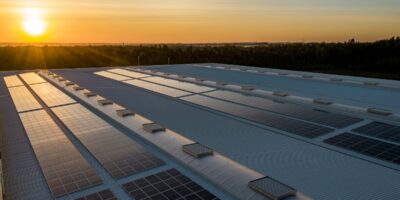Introduction
The renewable energy industry has seen significant growth in the past few decades, and solar energy is one of the fastest-growing sectors within the industry. As a result, solar energy trade shows have become an important platform for industry experts, manufacturers, suppliers, investors, and policymakers to gather and exchange knowledge about the latest technologies and trends in the industry.
Definition of Solar Energy Trade Shows
A solar energy trade show is a specialized event that brings together companies, individuals, government agencies, non-profit organizations, and other stakeholders to showcase their products and services related to solar power generation. The events typically include exhibitions, demonstrations of new technologies or products, workshops or training sessions on industry best practices, and keynote speakers from leading companies.
Importance of Solar Energy Trade Shows
Solar energy trade shows play a critical role in advancing the adoption of solar power generation across the world. They allow stakeholders to share knowledge about innovative technologies that drive growth in this sector. Furthermore, these events offer an important platform for networking among key players in the sector which can lead to increased collaboration and partnerships between businesses.
Solar energy trade shows also serve as a forum for dialogue between policymakers and key stakeholders within the sector on issues related to regulatory frameworks or environmental policies that impact renewable energy deployment. These discussions help shape future policies promoting sustainable development across global economies.
Purpose of Outline
This article aims to provide an overview of solar energy trade shows by exploring their history and evolution. It will examine how they have become increasingly important to all aspects of this rapidly growing industry, including manufacturers who produce equipment like panels or inverters; installers who place them onto rooftops or into utility-scale fields; financiers who back projects financially, such as banks or private equity firms as well as policymakers that shape regulations that impact solar power generation across the globe.
Overview of Solar Energy Trade Shows
History and Evolution of Solar Energy Trade Shows
The first solar energy trade show was organized in 1975 in Atlanta, Georgia, by the Solar Energy Industries Association (SEIA), which aimed to promote the use of solar energy as a viable source of electricity. Since then, solar energy trade shows have grown in popularity and have become a key platform for industry professionals to showcase their products and services. Today, these trade shows attract thousands of attendees worldwide and are major events on the industry’s calendar.
Over the years, solar energy trade shows have evolved significantly to keep pace with technological and industry trends. Initially, most trade shows were focused on showcasing residential solar systems. Still, with technological advances and growing demand for commercial applications, many trade shows now also cater to large-scale solar projects such as utility-scale installations or community microgrids.
Types of Solar Energy Trade Shows
There are several types of solar energy trade shows catering to different audiences. Some focus on specific technologies or services related to solar energy, while others cover a broader range. For instance:
– Photovoltaic (PV) Conferences: These conferences focus on PV technologies such as cells, modules, inverters, etc. – Solar Thermal Conferences: These conferences focus specifically on thermal technologies such as concentrated solar power (CSP) systems.
– Industry-Specific Conferences: These conferences focus on sectors like utility-scale installations or community microgrids. – General-Purpose Conferences: These conferences cover various topics that relate broadly to the renewable energy sector.
Key Players in the Industry
Several key players participate in these events, including manufacturers, suppliers, distributors, government agencies promoting green initiatives, and research organizations. The largest players include well-known brands like Trina Solar, JA Solar, Yingli Green Energy, and First Solar. Key players include Enphase Energy, SolarEdge Technologies, and SMA Solar Technology.
These events also draw in new companies looking to make a name for themselves in the industry or start-ups hoping to gain exposure. Furthermore, industry professionals like engineers, designers, and salespeople attend these events to keep abreast of cutting-edge technologies and industry trends and network with other professionals.
Benefits of Attending Solar Energy Trade Shows
Networking Opportunities with Industry Experts
One of the most significant benefits of attending a solar energy trade show is the chance to network with other professionals in the industry. These shows bring together experts from all aspects of solar energy, including manufacturers, installers, researchers, and policymakers. You can connect to new business partnerships or collaborations by attending these events.
In addition to formal networking events, most trade shows offer informal opportunities for attendees to connect and exchange ideas. The exhibit hall is an excellent place to meet new people and learn about new products and technologies.
Attending sessions or workshops focused on your area of interest can also be helpful. These sessions allow you to meet other professionals who share your passions and exchange ideas about best practices in your field.
Access to New Technologies and Products
Another significant benefit of attending solar energy trade shows is the opportunity to learn about new technologies and products in the industry. Exhibitors at these events often showcase their latest innovations, allowing attendees to see firsthand what’s new in the market.
In addition to learning about products already on the market, attendees can also get a sneak peek at upcoming technologies still in development. This knowledge can be invaluable for those looking to stay ahead of their competition or stay abreast of emerging trends.
Educational Sessions on Industry Trends and Best Practices
Solar energy trade shows are also an excellent source of education on industry trends and best practices. Most events offer seminars or workshops geared towards professionals looking to expand their knowledge base on specific topics within the industry. These sessions provide valuable insights into areas like solar panel manufacturing advancements, smart grid integration for solar power systems, and climate change affecting growth in the industry, amongst others.
By attending educational sessions at trade shows regularly, you can keep up to date with the latest trends and best practices in your area of interest. This knowledge can help you better serve your clients or contribute meaningfully to your organization’s goals.
Top Solar Energy Trade Shows Around the World
Intersolar Europe: Where Innovation Meets Renewable Energy
Intersolar Europe is one of the world’s most prominent renewable energy trade shows. Held annually in Munich, Germany, it attracts thousands of exhibitors and visitors worldwide.
The event provides an ideal platform for innovators, investors, policymakers, and industry experts to showcase new products, share ideas and forge partnerships. One unique feature of Intersolar Europe is its focus on cutting-edge technologies transforming the renewable energy sector.
The trade show covers many topics, including photovoltaics (PV), solar thermal technologies, and solar energy storage solutions. Attendees can also access educational sessions to learn about key industry trends.
Solar Power International (SPI): The Largest Solar Event in North America
Solar Power International (SPI) is an annual event that brings together North America’s solar energy community under one roof. Held at different locations each year, SPI aims to showcase groundbreaking technologies driving innovation in the sector.
The event attracts over 700 exhibitors and 17,000 visitors from more than 100 countries. One notable feature of SPI is its comprehensive educational program that covers all aspects of the solar energy industry.
Attendees can participate in seminars on project financing, regulatory compliance, and market trends. The event also offers networking opportunities for professionals looking to expand their business contacts.
Solar Power Northeast: Tackling Energy Challenges with Solar Solutions
Solar Power Northeast is a regional renewable energy trade show held annually in Boston, Massachusetts. Co-hosted by SEIA (Solar Energy Industries Association) and SEPA (Smart Electric Power Alliance), this event addresses challenges facing the Northeastern part of America’s electric grid system through innovative solar solutions.
One of the key highlights of Solar Power Northeast is its interactive exhibition hall, featuring live product demonstrations and educational sessions on energy storage, community solar, and other emerging solar technologies. Attendees can also network with industry thought leaders and policymakers to gain insights into the region’s future of the solar energy sector.
Niche Subtopics Covered in Solar Energy Trade Shows
Solar storage systems and battery technology
Solar energy trade shows also provide a platform for showcasing solar storage and battery technology advancements. One of the major challenges of using solar energy is its intermittent nature, with the availability of energy depending on the weather and time of day. However, as batteries become more advanced, it is becoming increasingly possible to store excess solar power during peak production times to use during periods of low production.
One example of emerging battery technology is the lithium-ion battery, which has higher energy density than previous technologies, enabling longer-lasting batteries with faster charging speeds. Other advancements include flow batteries that can store large amounts of renewable energy for hours or even days.
These technologies have significant implications for off-grid and microgrid applications and homes and businesses that want to reduce their reliance on grid electricity, in addition to technological advancements, solar storage systems are also impacted by government policies around net metering and feed-in tariffs.
These policies affect how much money homeowners or businesses can earn by selling excess electricity back to the grid. As these policies evolve, it will be important for industry professionals to stay abreast of changes by attending solar energy trade shows.
Smart grid integration for solar power systems
An emerging area within the field of solar energy is smart grid integration for solar power systems. Smart grids rely on digital communication technology to monitor and control electricity flows in real-time. By integrating smart grids with distributed renewable energy resources such as rooftop solar panels or community solar gardens, it becomes possible to optimize the use of renewable resources while maintaining grid stability.
Solar energy trade shows offer a forum for industry leaders in smart grid integration to share their insights into developments such as virtual power plants, which integrate multiple small-scale renewable energy sources into a single virtual power plant. Smart grid integration also involves using smart meters, which provide detailed information on customer energy usage patterns and can help utilities better manage the grid.
Integrating solar energy and smart grids offers numerous benefits, including increased grid reliability and resilience, reduced greenhouse gas emissions, and improved energy security. By attending solar energy trade shows, industry professionals can better understand how these technologies are evolving and learn about new products being developed to support smart grid integration.
Solar panel manufacturing advancements
Solar energy trade shows provide an opportunity to learn about new advancements in solar panel manufacturing. This includes new materials for making solar panels and new techniques for manufacturing them more efficiently.
One area of focus is reducing the cost of producing silicon-based photovoltaic cells – which currently make up more than 90% of all solar panels – by developing thinner wafers or using alternative materials such as perovskite or thin-film technology. Another area is improving recycling technologies for end-of-life photovoltaic modules to reduce waste in landfills.
Additionally, advancements in automation and robotics are making it possible to manufacture solar panels more quickly and with greater precision than ever before. As with other aspects of the industry covered in this article, government policies play an essential role in shaping the direction of research and development in solar panel manufacturing.
For example, incentives or subsidies may be available for companies that invest in green manufacturing practices or meet specific recycling targets. By attending Solar Energy Trade Shows that cover these topics, attendees will stay informed on all the advances.
The Role of Government Policies in Shaping the Industry
Government policies play a crucial role in shaping the solar energy industry. In recent years, governments worldwide have introduced policies and regulations to promote renewable energy sources like solar power.
Some of these include tax incentives for solar panel installations, renewable portfolio standards requiring utility companies to generate a certain percentage of their power from renewable sources, and net metering programs allowing homeowners with solar panels to sell excess power back to the grid. However, government policies are not always consistent or predictable, and political leadership changes can significantly impact the industry.
For example, when President Trump announced tariffs on imported solar panels in 2018, it caused disruptions in the industry and uncertainty for developers and manufacturers. Those involved in the industry must stay informed about government policies at all levels – local, state, national, and international – as they can significantly impact business operations and growth prospects.
How Climate Change is Affecting the Growth of the Industry
As concerns about climate change continue to grow worldwide, so does interest in alternative energy sources like solar power. The more people become aware of how our planet is affected by greenhouse gas emissions from fossil fuel-based energy systems, such as coal-fired power plants or oil-fired generators; they are looking for cleaner alternatives that can help reduce carbon emissions. The increasing number of natural disasters related to climate change has also raised awareness about the need for reliable backup solutions, such as battery storage systems that work alongside Solar PV panels.
Additionally, scientists predict that climate change will lead to changes in weather patterns which could affect how much sunlight reaches different parts of the world. While this may seem to impact Solar PV systems at first glance negatively, research shows that new technologies, such as thin film PV cells, will be less affected by varying light conditions than traditional panel systems.
The Impact of International Relations on Global Solar Energy Trade Shows
Solar energy trade shows are not isolated events but are connected to global politics and the economy. The United States and China, two of the largest players in the solar industry, have had a complex relationship in recent years that has affected solar energy trade shows. President Trump’s tariffs on imported solar panels from China created tensions between the two countries, causing business uncertainty and potential disruption for international solar energy trade shows.
Additionally, international climate agreements like the Paris Agreement or other local initiatives such as green bonds drive investment in renewable energy sources across borders. This trend is particularly evident in emerging markets experiencing high population growth rates and rapid industrialization.
Overall, those involved in Solar Energy Trade Shows must keep up with global developments to understand how trends like policy changes or climate emergencies could impact the industry. By staying informed, exhibitors and attendees can make more informed decisions about participating in these events and help shape the future of clean energy worldwide.
Conclusion
Solar energy trade shows are a crucial component of the solar industry. They bring together experts worldwide to discuss ideas, share experiences, and showcase new technologies.
In this article, we have looked at the history and evolution of these shows and how they have grown in importance over the years. We also explored some benefits of attending these events, such as networking opportunities with industry experts, access to new technologies and products, and educational sessions on industry trends and best practices.
Additionally, we highlighted some of the top solar energy trade shows worldwide and niche subtopics covered in these events, like Solar storage systems and battery technology. Looking ahead to the future outlook for solar energy trade shows, we can expect continued growth in attendance rates as more companies invest in renewable energy solutions.
With advancements in technology continuing to drive innovation within this sector, such as smart grid integration for solar power systems or breakthroughs in manufacturing processes, there will be an even greater need for organizations to come together to share knowledge about how best practice installations work. Overall it is clear that Solar Energy Trade Shows will continue to play an essential role in building a sustainable future by promoting innovation through knowledge sharing among professionals pushing boundaries within this rapidly evolving industry.






